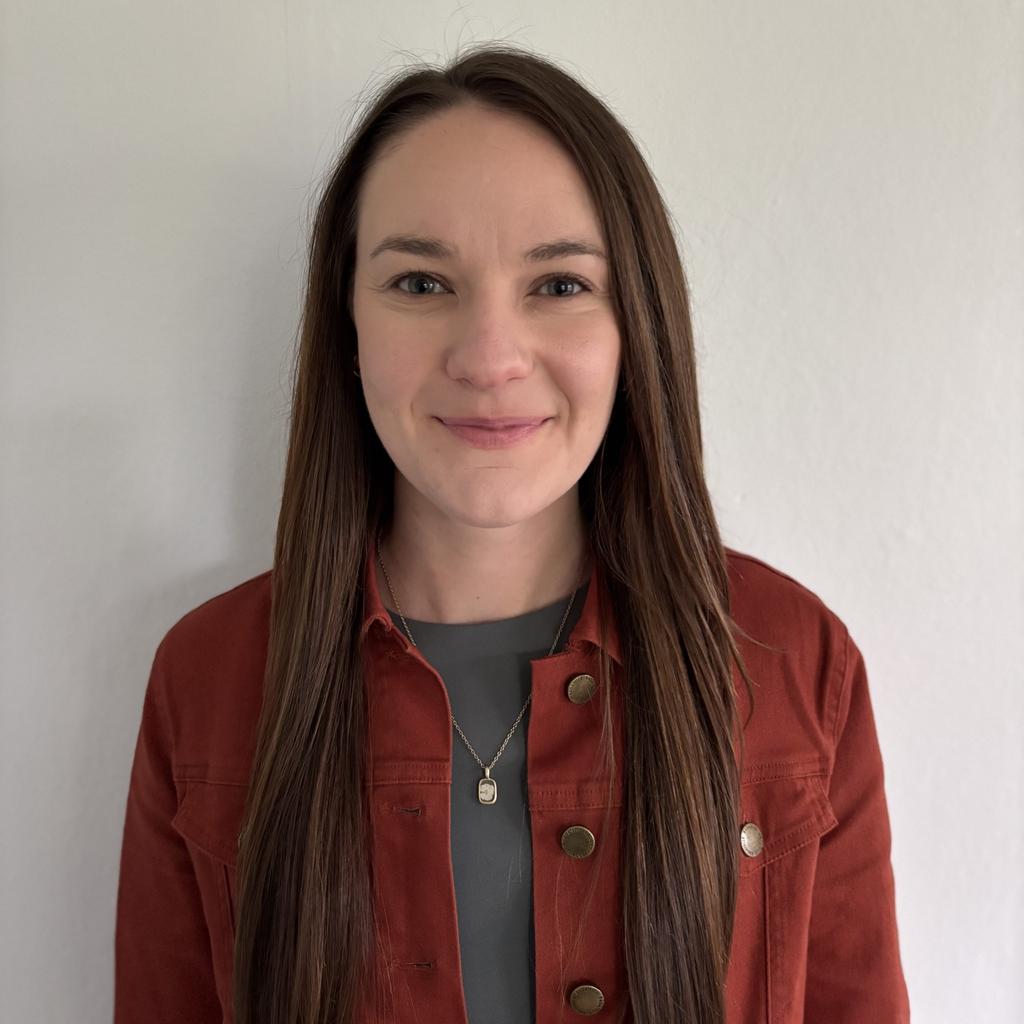Why this resume works
- Highlights industry-specific skills: By focusing on specialized skills like 3D modeling, texturing, and VFX optimization, the applicant aligns their expertise with industry demands for game design and film production roles.
- Quantifies accomplishments: Measurable accomplishments like saving $5K in project costs and contributing to $500M grossing films reflect the applicant’s tangible impact.
- Uses action-oriented language: Strong action verbs, such as designed, optimized, and implemented, highlight the applicant’s active approach to problem-solving.
More 3D Artist Resume Examples
Our 3D artist resume examples demonstrate how to highlight your creativity, technical skills, and project experience. Use these art resume samples to craft a resume that showcases your strengths and positions you as a strong applicant in the 3D art industry.
Entry-Level 3D Artist
Why this resume works
- Effective use of keywords: By weaving in industry-specific keywords like 3D Modeling and Visual Effects, the applicant ensures their resume is optimized for applicant tracking systems (ATS).
- Centers on academic background: The education section, featuring a master’s in animation and visual effects, lays a strong foundation for this early-career professional’s creative journey.
- Shows digital literacy: Mastering tools such as 3D modeling and rendering showcases digital competence, aligning well with essential computer skills needed in today’s tech-driven roles.
Mid-Level 3D Artist
Why this resume works
- Includes a mix of soft and hard skills: Mixing technical prowess with interpersonal skills, the applicant thrives in team settings, boosting cohesion while driving creative and efficient project outcomes.
- Demonstrates language abilities: The applicant’s diverse language skills foster international collaborations, broadening communication channels across Spanish, French, and Italian-speaking teams.
- Points to measurable outcomes: Clear measurable results, like improving project speed by 20% and cutting rendering time by 25%, showcase the applicant’s impactful contributions to efficiency and quality.
Experienced 3D Artist
Why this resume works
- Showcases impressive accomplishments: Highlighting standout achievements like boosting project delivery by 30% and reducing costs, the applicant’s accomplishments reflect impressive senior-level performance.
- Focuses on work history: By using a chronological resume format, the applicant emphasizes extensive work history, showcasing progression from junior designer to senior artist roles over a decade.
- Lists relevant certifications: Listing certifications such as Certified 3D Artist and Advanced Maya Techniques on the resume, the applicant’s commitment to learning and expertise in their field is evident.
3D Artist Resume Template (Text Version)
Larry Garcia
Westbrook, ME 04093
(555)555-5555
Larry.Garcia@example.com
Professional Summary
Experienced 3D Artist with 8 years in creative roles designing, optimizing and delivering high-quality assets for AAA games, films, and digital projects. Proficient in cutting-edge technologies like 3D modeling, texturing, and VFX workflows that amplify collaboration and project performance.
Work History
3D Artist
PixelCraft Studios – Westbrook, ME
June 2020 – May 2025
- Designed 3D assets with 25% faster delivery
- Optimized textures saving K project costs
- Collaborated with 15 cross-functional teams
Digital Sculptor
Animatrix Creatives – Portland, ME
May 2016 – May 2020
- Modeled game-ready assets boosting playability 30%
- Implemented high-poly workflows cutting errors by 20%
- Delivered 20 stylized characters for AAA titles
Visual Effects Modeler
RenderPro VFX – Portland, ME
June 2012 – April 2016
- Created environment assets reducing rendering time 15%
- Contributed to 5 feature films grossing 0M
- Developed materials optimizing global VFX pipelines
Skills
- 3D Modeling
- Texturing & Shading
- Digital Sculpting
- Animation Workflow
- UV Mapping
- Game Asset Production
- Rendering Techniques
- VFX Asset Optimization
Education
Master of Fine Arts 3D Design & Animation
ArtCenter College of Design Pasadena, California
May 2012
Bachelor of Arts Digital Media Arts
University of California, Los Angeles Los Angeles, California
June 2010
Certifications
- Certified 3D Artist Professional – CG Society
- Unity Certified Developer – Unity Technologies
Languages
- Spanish – Beginner (A1)
- French – Intermediate (B1)
- German – Beginner (A1)
Related Resume Guides
Advice for Writing Your 3D Artist Resume
Discover our advice on how to write a resume for a 3D artist position and learn how to highlight your creative skills, technical expertise, and unique artistic vision.
Showcase your portfolio or projects
For a 3D artist, showcasing your work through a portfolio and listing projects on your resume is key. This visual display lets potential employers see your skills and creativity in action. It’s not just about listing what you can do; it’s about showing it.
A well-crafted portfolio brings to life the texture, depth, and detail that words alone can’t convey. Whether you’re applying for a full-time job or freelance opportunities, your portfolio can make a strong impression.
Linking to an online portfolio on platforms like Behance or Dribbble, or even hosting your website, gives recruiters easy access to your work. If you prefer including select projects directly on your resume, treat them like work experience entries.
For each project, list the name and any client or company involved. Offer a brief description of what the project was about and highlight your key contributions and the impact of your work.
Don’t hesitate to include freelance assignments, school projects, or personal side projects in your showcase. These experiences are valuable and show off versatility and initiative as a 3D artist. Diverse projects demonstrate that you’re adaptable and willing to explore different styles and techniques.
Example of a projects section
3D Character Modeling for Indie Game
Pixel Dynamics
March 2022 – November 2022
- Developed high-detail 3D character models using Blender, improving visual storytelling.
- Worked closely with animators to ensure seamless rigging and animation compatibility.
- Optimized assets for game engine integration, maintaining performance standards.
Architectural Visualization for Residential Complex
Urban Visuals Studio
June 2021 – February 2022
- Created photorealistic renderings of a residential complex using Maya and V-Ray.
- Collaborated with architects to accurately depict design concepts and materials.
- Produced virtual walkthroughs that helped secure client approvals and investments.
For additional inspiration, we recommend exploring our library of professional resume examples for various job titles, industries, and experience levels.
Emphasize your most relevant skills
As a 3D artist, it’s important to balance both technical and soft skills in your creative role. Technical skills are the backbone of your work, involving software like Blender, Maya, or ZBrush.
These tools help you bring ideas to life with precision and detail. But don’t forget about soft skills like communication and teamwork. They help you share your vision and work well with others, which is key in collaborative projects.
To make sure your skills stand out, include a skills section on your resume to list the software you know how to use and any artistic talents that make you unique. By organizing this information separately, hiring managers can quickly see what you’re good at before diving into your work experience.
Also, try weaving these skills into your job history bullet points for more impact. For example, instead of just saying “Created 3D models,” say “Used Blender to design detailed 3D character models that improved project storytelling.” This way, employers see not only what you’ve done but also how you’ve used specific tools or abilities in real-world situations.
For 3D artists, a resume format that highlights skills in modeling, texturing, and animation can effectively showcase their creative expertise.
Choose a professional resume template
When choosing a resume template as a 3D artist, it’s important to find one that balances creativity and professionalism. A clean, structured layout can show off your skills effectively without overwhelming the reader.
Look for templates with clear sections and headings that naturally guide the eye through your resume. This approach highlights your experience and talents while keeping everything organized.
Select a format designed for ATS compatibility. Many companies use these systems to scan resumes before they reach hiring managers, so making sure your resume is easy for them to read is key.
Avoid overly decorative fonts or graphics that might confuse ATS software. Instead, choose templates with simple, professional fonts and spacing to keep things clear and accessible.
Use our Resume Builder to make your 3D artist resume stand out with cool templates. You can easily change the layout and highlight your best skills.
Format your resume properly
Proper formatting, like using the right resume format, is key for readability and professional appeal. A chronological resume suits a 3D artist with steady experience, highlighting career progression by listing past roles in reverse order. For those with less experience, a functional resume can better showcase skills such as modeling, texturing, and animation over work history.
5 resume formatting tips
- Use clear section headings: Organize resume with sections like work experience, skills, and portfolio for easy reading.
- Choose readable fonts: Opt for fonts such as Arial or Calibri in 10-12 pt size to ensure clarity.
- Implement bullet points: Summarize responsibilities and achievements using bullet points for quick scanning.
- Aim for one-page length: Keep your resume to one page unless you have extensive experience to showcase.
- Ensure proper spacing and alignment: Maintain consistent spacing and alignment throughout the resume for a neat appearance.
Use our ATS Resume Checker to find formatting errors, missing keywords, and other issues in your resume.
FAQ
Do I need to include a cover letter with my 3D artist resume?
Yes, including a cover letter with your 3D artist resume can strengthen your application and help you stand out to employers. A cover letter gives you the chance to explain your creative process, highlight specific projects or skills, and show how they align with the role or studio’s artistic vision.
For example, if the company specializes in character modeling or environmental design, you can mention related experience and share your enthusiasm for contributing to their work.
You can also use it to briefly describe how your technical expertise—like skill in software such as Blender or Maya—has helped solve challenges in past projects. You can find cover letter examples to guide you in crafting an effective one.
Taking this extra step demonstrates professionalism and passion for the role, which is especially important in creative industries like 3D art. Try using our Cover Letter Generator for a personalized touch.
How long should a 3D artist’s resume be?
For a 3D artist, a one-page resume is typically enough to showcase your core skills, software expertise, and standout projects. Focus on the programs you’re skilled in—like Maya, Blender, or ZBrush—and highlight specific accomplishments like game-ready models or cinematic-quality assets.
If you have extensive experience or a broad portfolio of relevant work, a two-page resume may be appropriate. Just make sure every detail adds value and speaks directly to your abilities as a 3D artist.
Explore resources on how long a resume should be to better tailor it for your experience level and career goals.
How do you write a 3D artist resume with no experience?
If you’re just starting as a 3D artist, your resume should highlight your skills, education, and personal projects that show off your potential. Here are a few tips:
- Start with a strong summary: Write a brief statement about your passion for 3D art and any software expertise (like Maya, Blender, or ZBrush) to grab attention.
- Emphasize education: If you studied 3D modeling, animation, or digital art in school or through online courses, list those prominently along with specific coursework like texturing or rigging.
- Showcase personal projects: Include details of personal or freelance work. Highlight what tools you used and the creative challenges you solved—even if they were non-commercial. Link a portfolio if possible.
- Highlight transferable skills: If you’ve done graphic design, video editing, or other digital media work, mention how those improve your understanding of composition and storytelling.
Tailor each section to emphasize creativity and technical strengths while keeping an organized layout so hiring managers can quickly see your potential. Check out how to write a resume with no experience for more tips and examples.
Rate this article
3d Artist
Additional Resources
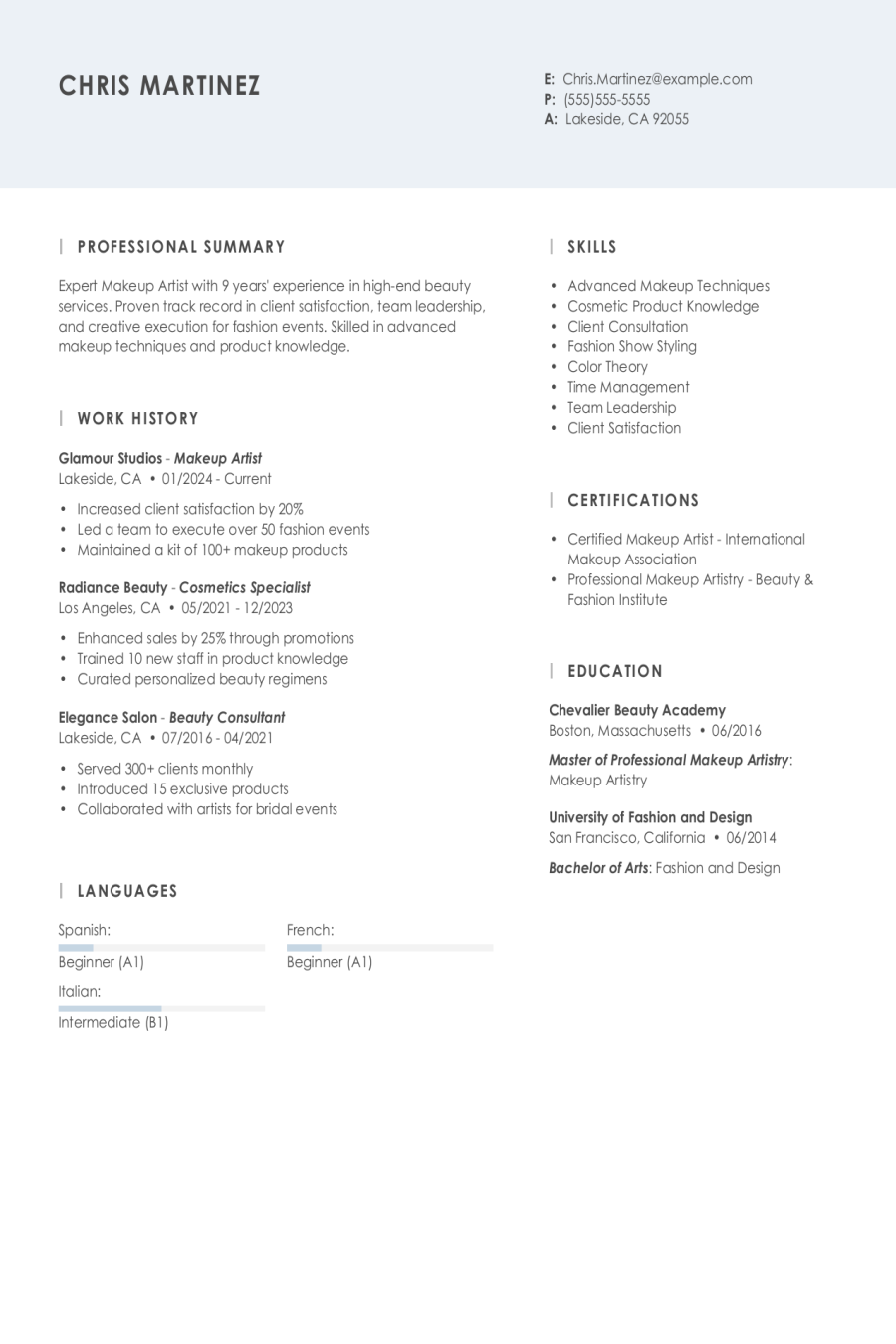
Makeup Artist Resume Examples & Templates for 2025
Discover makeup artist resume examples to see how you can highlight your creativity and technical skills. Learn to showcase your experience with beauty techniques for a show-stopping resume.Build my resumeImport
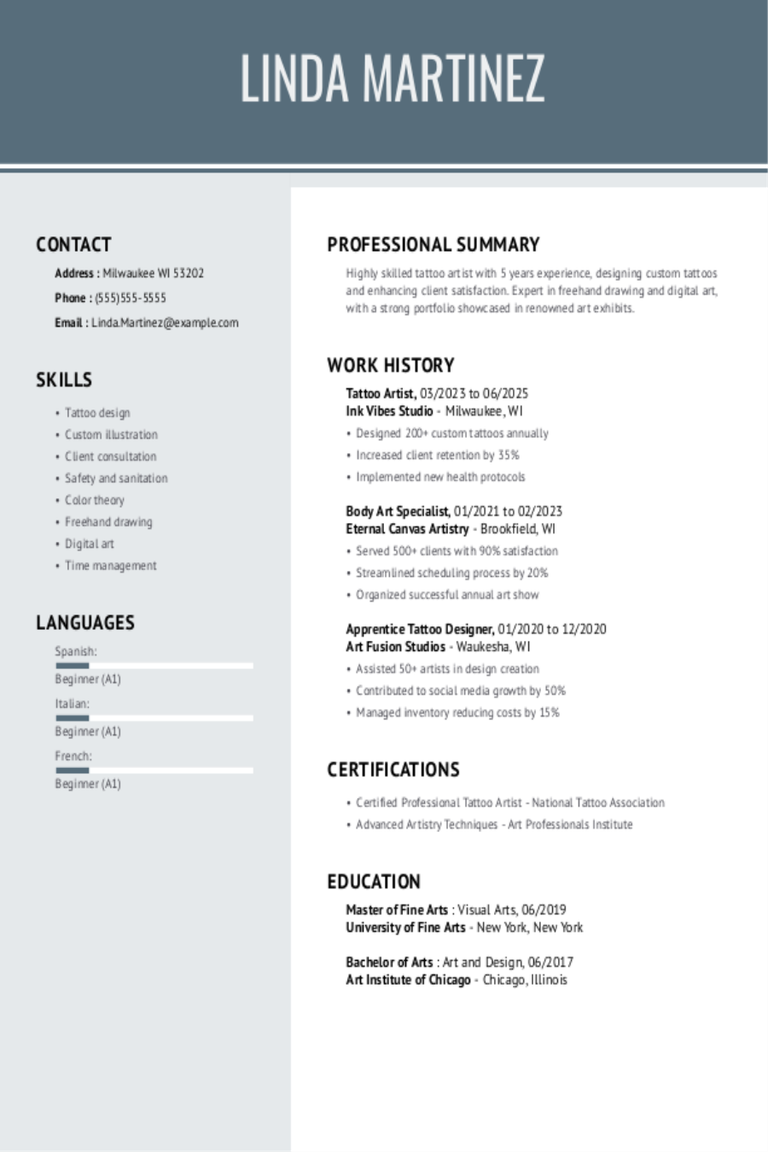
Tattoo Artist Resume Examples & Templates for 2025
Explore tattoo artist resume examples to see how to highlight your artistic talent and experience. Browse tips for showcasing your creativity, client interactions, and portfolio to impress potential employers.Build my
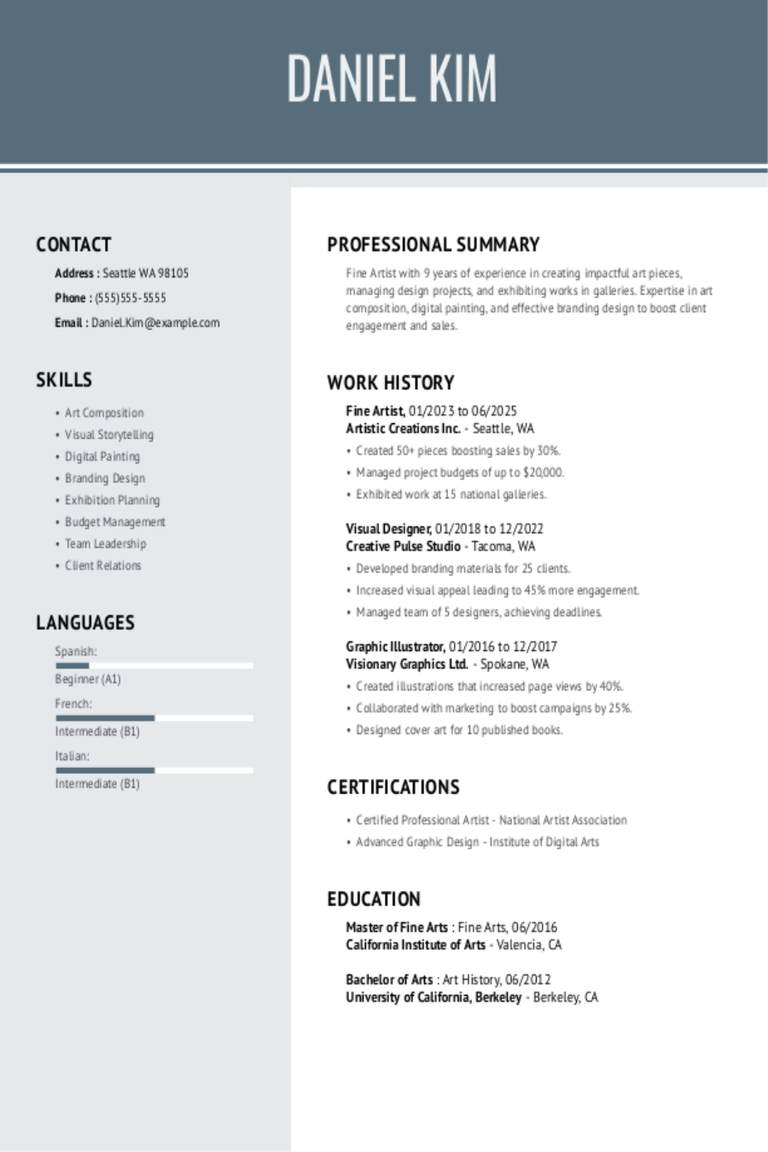
Fine Artist Resume Examples & Templates for 2025
Explore fine artist resume examples to see how to showcase your creativity and unique style. Use these tips to highlight your skills, projects, and exhibitions that demonstrate your artistic talent
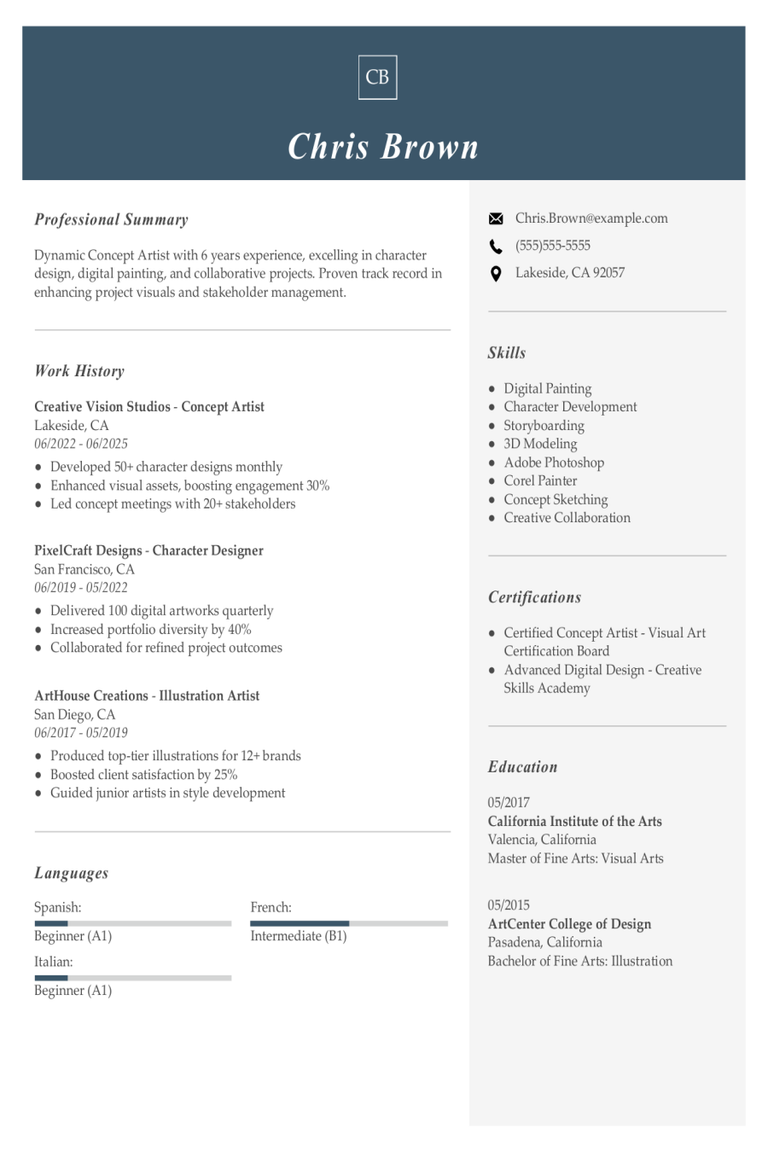
Concept Artist Resume Examples & Templates for 2025
Explore concept artist resume examples and tips to learn how to showcase your creativity, drawing skills, and how you bring ideas to life.Build my resumeImport existing resumeCustomize this templateWhy
